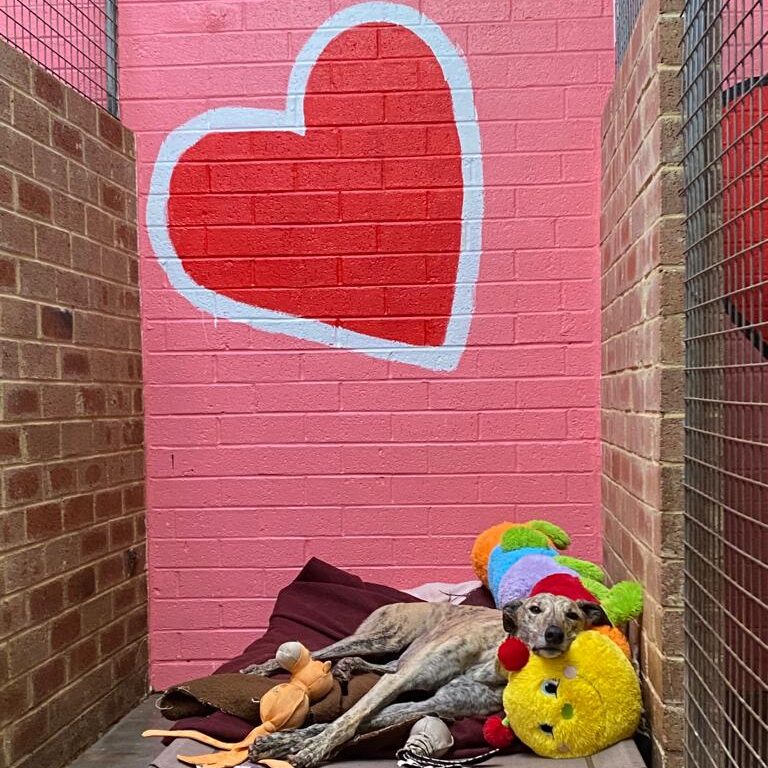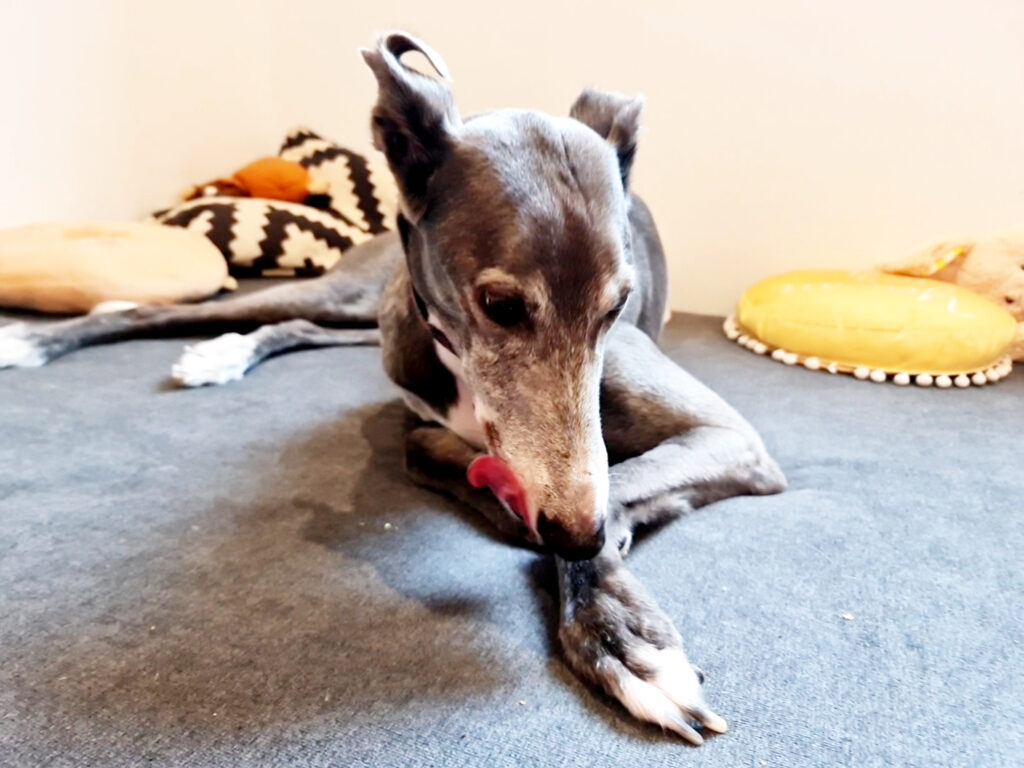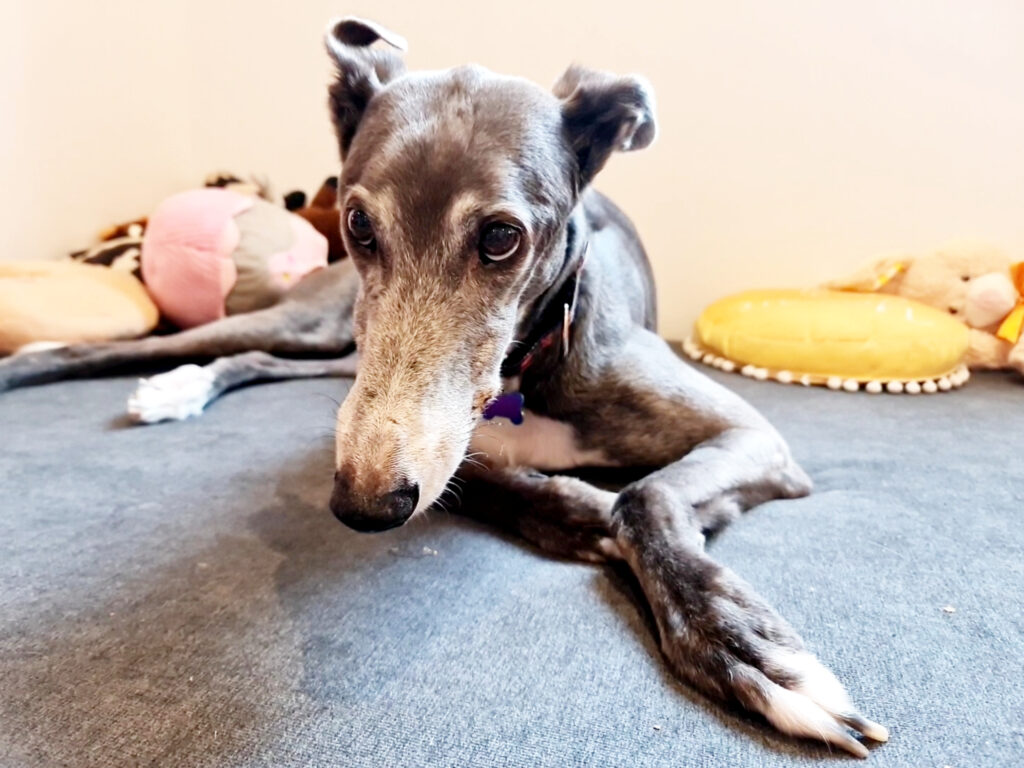
Let’s talk about why Greyhound Rescue recommend that we don’t pat, hug or approach hounds on their beds. Resource guarding of beds is not uncommon for a greyhound adjusting to companion life. Greyhounds are raised in kennel environments, not homes like your average companion dog such as a Labrador or a staffy! They are not handled and exposed to the same experiences as companion dogs.
Lets paint a picture so you can get an idea of why it is important to give our hounds space while they are on their bed.
It’s 6am in the morning, imagine a kennel (similar to the one at Greysland) with 20 kennels filled with hounds, one hound in each kennel. Right at the end of one kennel row, there is a beautiful female hound who had a litter of 6 puppies, who are now 8 weeks old. This female hound was woken by the sounds of the other hounds barking and howling as they heard their handler unlocking the main doors to the kennel and starting to let the other hounds out.
The puppies are woken by their mother waking up to join in on the morning howling chorus. Today is the day the puppies are completely weaned from their mother and start being separated into kennels, they may still share a kennel with a sibling or two at this stage.
A few more weeks pass, some pups have been sold to other trainers, but one male puppy remains. The kennel routine continues for the male pup, every morning he wakes up at 6am to the sounds of his neighbour hounds barking or his handler opening the doors. He waits at the gate of their kennel for his handler, busting to get out so he can have a toilet break and spend a bit of time outside while his kennel is cleaned.
Throughout this time the male pup has never been handled on his bed or in the kennel. He is only handled when he’s being taken out of his kennel, to go for a trip to the vets, or start some socialisation or racing training. This routine is continued into the pup’s adulthood and throughout his racing career
Fast forward to the hound arriving at Greysland, he was retired from racing at the age of 3 due to a small injury. He has spent some time with Greyhound Rescue while he is trained and assessed to be placed into a new home, but his routine is fairly similar as he’s in a kennel environment surrounded by other hounds, woken up by the sounds of his neighbouring hounds.
Today is the day he goes to his new home. It’s a stressful time for him! He’s never been in a house before, his routine is very different and there are lots of sights and sounds that he has never seen before. But he has a comfortable bed all for himself, and this makes him happy.
The hound’s new owner starts patting him while he’s on his bed. “Good dog” says the owner as they pat the hound on the head and continue on their way. This made him feel uncomfortable, he’s never had anyone approach him in his space before, so he communicates this by giving a little tongue flick. The following days the hound continues to communicate his unease about being approached on his bed, but clearly the tongue flick was not working so the next time he tries a whale eye, or a big yawn. That doesn’t work for the hound either, so maybe next time he will try and “freeze”, but this also doesn’t work and he feels like he is not being listened to.


A few days later the hound is laying on his bed and sees his owner walking towards his bed. The hound is a little fearful he’s going to be approached on his bed again. He’s tried to communicate with his owner previously but it didn’t work, so what does he do next? The anxiety in the hound has built up and he decides to bark and lunge at his owner as he walks past his bed to prevent him from entering his space again.
Although barking and lunging at someone is not ideal, we need to understand that snapping, barking, growling or lunging is a form of communication. It doesn’t mean your hound doesn’t like you, it means that they are desperately trying to communicate something with you, something you may have missed or maybe your hound has had their space invaded in the past and they need help learning that they have a safe space that you will not invade.
Signs that your hound is uncomfortable:
- Licking their lips/ flicking their tongue out briefly
- Yawning
- Turning their head away from you
- Freezing (tense body, not moving)
- Whale eye (you can see white)
- Moving their body to use up more space
- Flattening themselves/lowering head and neck
It is when these subtle communications are ignored that you will see a progression to a growl, bark, or snap. It’s sometimes hard to read body language at first, and a lot of these signs can be fleeting, so be mindful to watch your hound and learning their language.
When you adopt a hound, you are adopting a working dog who needs time to adjust to being a companion. It is crucial that from the moment you bring your hound home you respect their space and check consent before approaching them. It’s best to call the hound to you, if they want a pat then they’ll get up. For more info on checking consent, click here.

